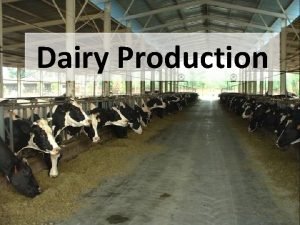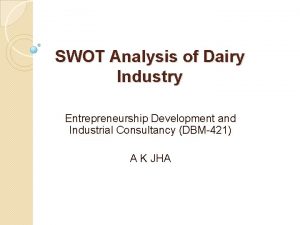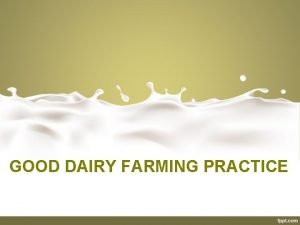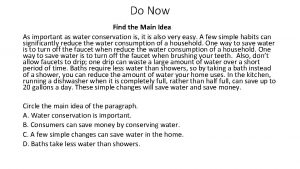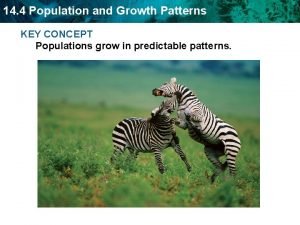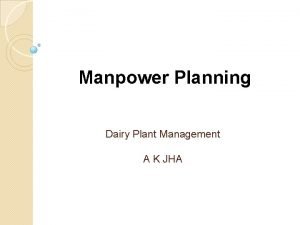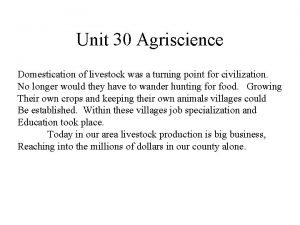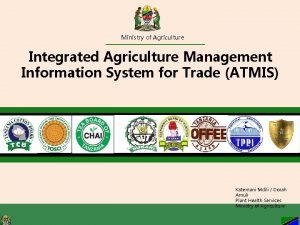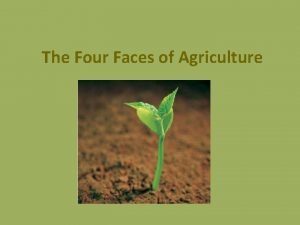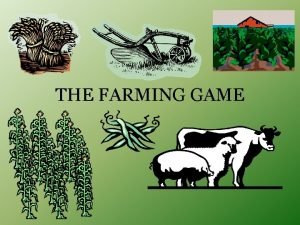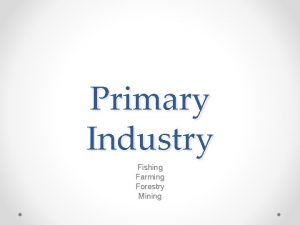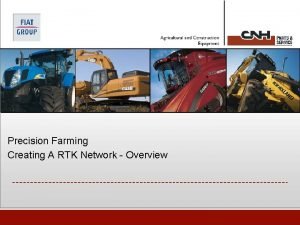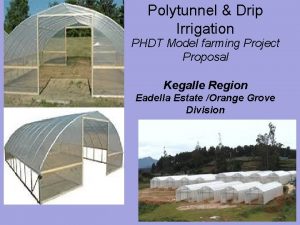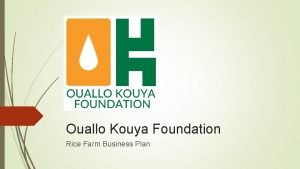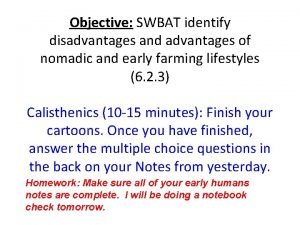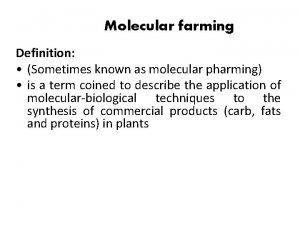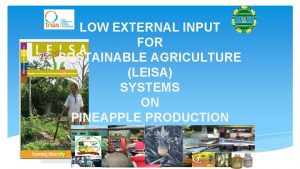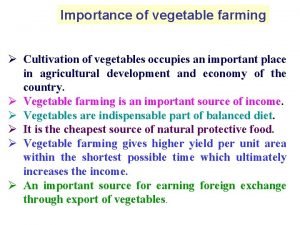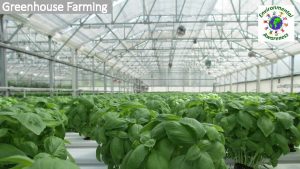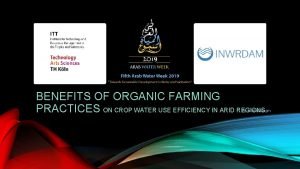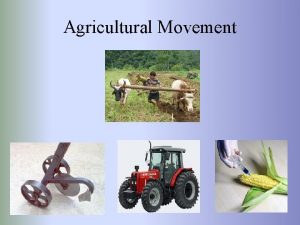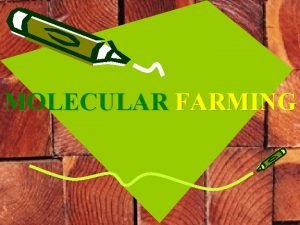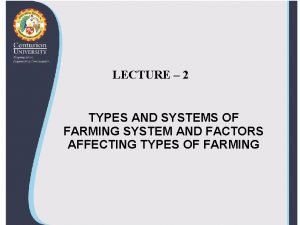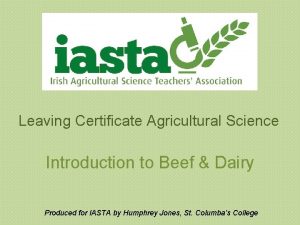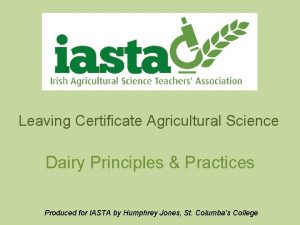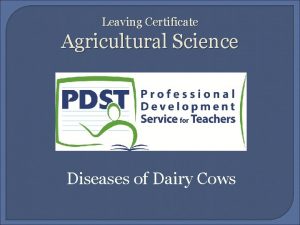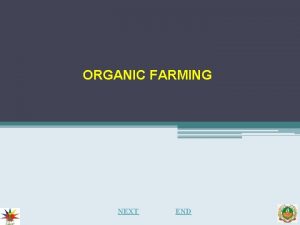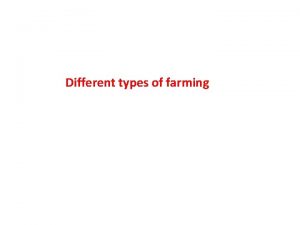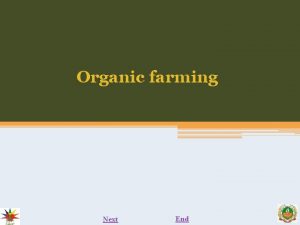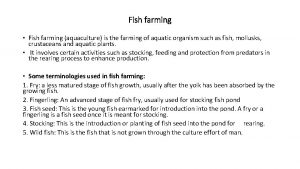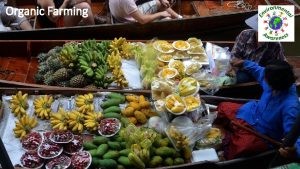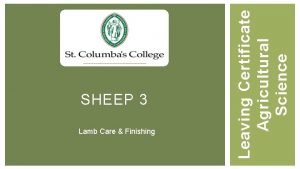Herd Management Leaving Certificate Agricultural Science DAIRY FARMING





















































- Slides: 53

Herd Management Leaving Certificate Agricultural Science DAIRY FARMING


INTRODUCTION Planning Milk Production Milk production in Ireland is a low cost system, based on producing milk from summer grass. For this reason, 80% of all calving on Irish farms occurs in the spring. Autumn calving is rare but mainly found in areas like Dublin and Cork where there is an all year demand for milk. Creameries compensate farmers who practice autumn calving. Planning dairy management requires two major considerations:

PLANNING DAIRY MANAGEMENT Planning Calving dates: All calves must be born in Jan / Feb so that best use can be made of the summer grass This requires very close attention to oestrous cycles of the herd and the use of Artificial Insemination. (AI) Balanced Grazing & Grass conservation: The amount of land allocated to summer grazing and the land set aside for winter-feeding must be carefully and accurately calculated. It must meet herd requirements. If feed shortages occur in the summer (due to not enough land being put away), yields will fall and concentrates will need to be purchased. But if shortages of silage and winter feed occurs this too will affect the herd (usually at the time of calving) So it is very important that the farmer calculates how much of his land he will use for grazing and how much for silage / other feeds.


CALVING The time during calving (January and February) is one of the most important in the farmer’s calendar. The sale of calves would account for nearly 30% of the farmer’s annual income so mistakes can be costly. The most important consideration is the care of the cow before and after calving and the care of the calf at birth and the first 24 hours of it’s life. Every year 6% of all calves die at birth and another 3% in the first week. Most of these are avoidable and are caused by silly mistakes. Mistreatment of the calf can also lead to injury of the cow, lower yields or even death.

RULES FOR SUCCESSFUL CALF MANAGEMENT Rule 1: Isolate the cow before calving Keeping records of breeding is very important as this can help the farmer know the exact date of calving. A vet or experienced farmer should check the cow regularly before this date looking for signs of the onset of calving. The cow should be placed in a calving box 1 -2 days before the predicted date. A calving box is small-disinfected box designed simply for calving purposes.

RULES FOR SUCCESSFUL CALF MANAGEMENT Rule 2: Have an experienced person present. The cow should be inspected day and night to ensure that some experienced person is present when she is giving birth. Rule 3: Obtain veterinary assistance if required. An experiences farmer may handle a normal delivery, with a helper. But if any problems arise, then a vet should be contact immediately. Many calf deaths are caused by delays in seeking such assistance.


MANAGEMENT DURING EARLY LACTATION After calving, the cow produces special milk called colostrum. This milk is not accepted in the creamery as it contains types of antibodies so the cow should not be returned to the herd straight away. The cow will continue to lactate until she becomes pregnant again (or for 2 years if suckled) but the farmer will aim for a period of 10 months. During this 10 month period the daily milk yield will vary considerable. The LACTATION CURVE shows the typical trend during the cows lactating period.

THE LACTATION CURVE

MANAGEMENT DURING EARLY LACTATION The cow must be fed enough nutrients so that she reach’s her full milking potential in the period up to and including the lactation peak. This is because the level of milk produced at the peak dictates the TOTAL LACTATION YIELD. The two general rules are as follows: TLY = Daily Yield at Peak X 200 (Normal) TLY = Daily Yield at Peak X 220 (Good conditions)

MANAGEMENT DURING EARLY LACTATION FEEDING AT THIS STAGE: The cow is fed for both maintenance and for production. The farmer can predict how much to feed an older cow for production. BUT for a first lactation cows, it is suggested to feed them higher than their yields would suggest. This is done to ensure that they reach their potential at the peak. In early lactation (FEBRUARY ON) there is not any fresh grass, so concentrates as well as silage must be fed to ensure the cow reaches her potential at the peak.

MANAGEMENT DURING EARLY LACTATION Although this is expensive, it is worth it in the long run as the cow will produce more milk. Cows are “turned out” onto grass as soon as possible – usually around March / April. The time depends on three things: § Spring Weather § Geographical location § Fertiliser use If the grass is scarce at first, then concentrates should still be fed to keep nutrients to a high level. Care should be taken of GRASS TETANY during this period.


CALVING INTERVALS & HEAT DETECTION The farmer will aim to have each cow calving every 12 months exactly. To do this, the farmer must be able to detect heat (oestrous) effectively. The gestation period of cattle is 9 ½ months. Therefore, there is only 2 ½ months after calving to get the cow pregnant, if she is to have a calf at the same time next year. Cows will come into heat 3 – 8 weeks after calving and every 21 days after.

SERVICING The cow should be serviced by a bull or AI at each heat period or else essential time will be missed. Detecting heat can be quite difficult, so the herd should be observed at least four times daily Cows will attempt to mount other cows during this time so tail painting is a good method (Similar to raddling) Most servicing of cows is done by Artificial Insemination. As soon as the cow is detected as being in heat, the AI station should be informed.

MID TO LATE LACTATION MANAGEMENT Two thirds of the total yield is provided in the first half of lactation. Therefore, at this time cows are able to maintain themselves and produce milk from well-managed grassland. The yield in late lactation is so small the cow may only be milked once a day. At this stage, cows are treated with medicine to help in the drying off process. Cows are dried off 2 months before calving. In this time, the calf inside the cow will be growing very rapidly.

MID TO LATE LACTATION MANAGEMENT Therefore the cow must be fed an increasing amount of food up to calving. The cow can be fed ad lib, which means as much as possible, but should be given a crude protein ration with this up to calving. And the cycle begins again at calving. We will now look at the life of the calf from birth:

CALF REARING Cows can be reared naturally by suckling the cow or artificially away from the mother. In dairy farming all rearing is done artificially as the farmer could not allow for the loss of milk. Calves being reared may be reared for two main reasons: 1. Heifer calves being reared as replacements for the dairy herd. 2. Heifer or bull calves being reared as weanlings or fattened up for beef production. Whatever the final purpose of the calf, the principles of rearing are the same.

1. FEEDING COLOSTRUM There are many differences between colostrum and normal milk and they are summarised below: Colostrum is a more concentrated material and contains large amounts of highly digestible materials. Most importantly however is the higher levels of protein in colostrum, much of which is made up with immunoglobulins. These substances are known as antibodies, which give the calf protection against certain diseases.


FEEDING COLOSTRUM - 2 Unlike the human baby, the calf is not born with these antibodies in their system, so it is vitally important that the young calf get colostrum as quickly as possible. The calf can absorb antibodies more quickly in the first 12 hours of its life, and the calf should ideally consumed 2 – 3 kg of colostrum in this period. It should be hand fed if the calf is too weak to suckle the mother. Colostrum should be fed to the calf for as long as it is available, usually 3 – 4 days. Excess colostrum can be used to feed other calves.

FEEDING COLOSTRUM - 3 It is exceptionally important for the calf to get colostrum in the first 12 hours of its life. Research has shown that the majority of deaths, illnesses and failure to grow properly in the first three months, are down to the improper intake of colostrum. If the cow dies during birth, colostrum from another cow may be used. Also it is important to freeze excess colostrum for this purpose. If none is available, a replacement can be produced from milk, eggs, cod liver oil and castor oil.

2. FEEDING MILK AND MILK REPLACER Milk is the food ideally suited to the digestive system of the calf. It is however app. 160% the cost of milk replacer and 300% the cost of concentrate ration. The calf however cannot digest concentrate ration at an early age, as its rumen (stomach) has not developed fully. The normal procedure, therefore, is to feed the calf using the following sequence of feeds: 1. Colostrum 2. Milk 3. Milk Replacer 4. Concentrate ration.


FEEDING MILK AND MILK REPLACER - 2 The quicker the calf can be weaned onto ration the better, as this means less cost. However, this may not happen until the calf is 5 - 6 weeks old. The digestive system of the calf is very sensitive and is easily upset. It is only in recent years has the use of milk replacer been perfected by most farmers in the rearing of calves. Milk replacer is prepared by mixing 125 g milk replacer powder to every 1 litre of water.

FEEDING MILK AND MILK REPLACER - 3 It must be fed gradually as the calf may react to it. This is usually done over a period of 4 – 5 days. Bucket fed calves are given 2 litres if milk replacer twice daily at body temperature. They may also be fed using an automatic feeder, where the calf can have as much as they wish. However this is only used with large amounts of calves, as the cost is much higher.

3. WEANING ONTO HAY AND CONCENTRATES Hay, concentrates and water should be available to calves as soon as they stop drinking Colostrum. At first the level of hay and concentrates they consume will be very low, but this will increase as the calf gets older. Both foods not only provide essential materials for the calf’s growth, but also contain microorganisms, which help develop the calf’s rumen flora and enable it digest fibrous material.


WEANING ON TO HAY AND CONCENTRATES - 2 By the time the calf is four weeks old, he / she should be eating 300 -400 g of concentrates daily. When the calf is weaned from milk replacer, he / she should be eating 500 g a day. At this time the calf is allowed onto grass, but is still fed concentrates, hay and water.

4. THE CALF ON GRASS Calves should be allowed onto grass until the weather is warm. The change from warm housing to cold outdoor conditions can cause a shock and can disturb the calf’s growth. Meals should be fed for 2 – 3 weeks after being put onto grass, to help the calf adjust to the new diet. Calves are selective grazers, and should always be kept on fresh, palatable grass and certainly should not be left graze pastures bare.

THE CALF ON GRASS - 2 They should graze under a leader – follower system. They should always graze in advance of older cows. This also inhibits the spread of stomach and lungworms. When grass is scarce at the end of the summer, concentrates should be fed. When calves are housed for the winter, they should weigh 200 kg.

THE REPLACEMENT HEIFER Cows need to be replaced in the herd at the arte of 20% per year. The main reasons for replacing are: 1. Poor milk yield with age 2. Infertile 3. Disease 4. Injury to udders 5. “Grading up” Grading up means replacing lower yield cows with better calves which should give higher yields. The rearing of replacement heifer calves is the same as previous.

TARGET WEIGHTS Jan 15 t h - Birth April 15 th – 72. 5 KG November 1 st – 200 KG § The calves should be fed good silage and concentrates over the winter to ensure they reach their next target. May 1 st – 300 KG § Heifers reach puberty at 8 – 12 months, but should not in calf until 15 months and they must weigh 300 KG. § Otherwise there would be serious calving problems. § If the calf is got in calf at May 1 st, it will calve in Mid – February at just two years old. November 1 st – 450 Kg Mid – February – 500 – 525 KG

THE REPLACEMENT HEIFER The farmer must remember that the heifers even after giving birth are not yet fully grown. Therefore, the cow must be fed for growth after birth as well as maintenance and production of milk.

DISEASES OF COWS Tuberculosis (TB) It affects all types of cattle, of all ages. Caused by Mycobacterium bovus Highly infectious Humans can also get this disease (A Zoonose) Symptoms Failure to Thrive Sweating Bad appearance

DISEASES OF COWS - 2 Advanced symptoms: Emaciation Coughing Fever and Death Prevention None really Don’t buy in stock Good farm hygiene No drinking from streams Treatment Slow veterinary assistance for TB All affected animals are culled

DISEASES OF COW - 3 Contagious abortion Caused by Brucella abortis All affected animals abort there foetuses in the 5 th to 7 th month of pregnancy Highly infectious Humans can also get this disease (A Zoonose) Can be spread through contact, either direct or indirect Symptoms Abortion in 5 th – 7 th month of pregnancy

DISEASES OF COWS - 4 Prevention Vaccination in heifer calves Regular testing of herd Good farm hygiene Rearing all replacement heifers Treatment All affected animals are culled

DISEASES OF COWS - 5 Mastitis Bacterial disease of the udder Infection occurs through the teat canal and is due to bad hygiene. Two types – clinical and sub-clinical Caused by nearly 20 different bacteria Symptoms Bacterial presence in milk. Approx 10% reduction in milk yield. Swelling of the udder Pain Clots in the milk General ill health

DISEASES OF COW - 6 Prevention Hygienic housing conditions Keeping milking machine spotlessly clean Using antiseptic teat dips Clean teat cups between cows with hot water Wash teat before milking Treatment Antibiotics work for the clinical type Note: no milk can be supplied to the creamery if there antibiotics in it.

OTHER DISEASES OF COWS Other diseases of cows include Milk fever Grass tetany Lameness Lice Red water

DISEASES OF CALVES Scour (Diarrhoea) Causes the greatest amount of death in calves each year. Two types: Nutritional and bacterial. The bacterial is highly contagious. Caused by bad hygiene or feeding management or both. Inadequate intake of Colostrum is also a cause. Symptoms Diarrhoea Listlessness Dehydration Death Nutritional scour symptoms: Ingestion of too much milk or milk replacer This causes a milk ball in the stomach which triggers the diarrhoea.

DISESAES OF CALVES - 2 Prevention Simply feeding at regular intervals and not over feeding. Treatment Fed with water or fluid replacer until the ball is gone. Veterinary assistance should be contacted if it is suspected as being bacterial.

DISEASES OF CALVES - 3 Virus pneumonia Very serious virus disease, which becomes more serious due to secondary infection by bacteria in the lungs. Spreads by poor ventilation in farm buildings. Symptoms Barely unnoticeable Coughing Fever Sudden death Prevention Providing well-ventilated housing for calves. Early detection and treatment.

DISEASES OF CALVES - 4 Treatment Isolate infected animals Antibiotics to cope with the bacterial invaders. Recovery is very slow and infected animals may have lung problems in the future.

DISEASES OF CALVES - 5 Naval ill or joint ill. Caused by E. coli. It enters the calf in the unhealed naval. Mainly due to bad hygiene and improper treatment of the naval after birth. Should have been dipped in iodine and tied with iodine soaked string. Symptoms Swollen, painful naval Swollen joints Abscesses in the liver Blood poisoning Death

DISEASES OF CALVES - 6 Prevention Good hygiene at calving Treatment Antibiotics Other diseases of calves: § Lice § Lead Poisoning

THE MILKING MACHINE 1. Vacuum Pump § § Creates a vacuum which is used to: Transfer milk to the receiving vessel To perform the milking process To transport detergent during the cleaning process. 2. Vacuum Line § Transmits the vacuum to the milking clusters and to the milking line. 3. Vacuum Regulator § Maintains the vacuum at a constant level


THE MILKING MACHINE 4. Pulsator § § This disrupts the vacuum in the outside of the teat cup (in the cluster) This squeezes in the rubber cup and performs the milking action. 5. Cluster and Teat Cup § This is attached to the cows udder during milking 6. Milk Line § § § This line transports the milk from the clusters to the receiving vessel There may be recording jars on each line to measure yields. Milk may be rejected at the recording jar.

THE MILKING MACHINE 7. Milk Pump § Transmits milk from the receiving vessel to the bulk tank. 8. Cooler § Milk passes through the cooler is cooled from 30 o. C to around 12 o. C 9. Bulk Tank § Milk is stored here before being transported to the creamery. 10. Wash line § Detergent is flushed through the clusters, milk line and cooler during the cleaning process.
 Commercial grain farming ap human geography
Commercial grain farming ap human geography Objectives of milk dairy visit
Objectives of milk dairy visit Swot analysis of milk industry
Swot analysis of milk industry Guide to good dairy farming practice
Guide to good dairy farming practice History leaving cert syllabus
History leaving cert syllabus Primary school leaving examination in chinese
Primary school leaving examination in chinese Leaving certificate
Leaving certificate A herd of elephants flies past you at sixty miles per hour
A herd of elephants flies past you at sixty miles per hour An elephant herd has mainly female and baby elephant
An elephant herd has mainly female and baby elephant Herd
Herd Herd learning
Herd learning Acnc governance standard 3
Acnc governance standard 3 What is the movement of a single caribou into a herd
What is the movement of a single caribou into a herd What is your favorite subject what subject
What is your favorite subject what subject Process control and product control
Process control and product control Dairy plant management
Dairy plant management Livestock breed identification: swine - vocabulary
Livestock breed identification: swine - vocabulary Agricultural quality management
Agricultural quality management Atmis kilimo
Atmis kilimo Agribusiness finance definition
Agribusiness finance definition Computer science certificate princeton
Computer science certificate princeton Certificate course in evidence based diabetes management
Certificate course in evidence based diabetes management Automated certificate management environment
Automated certificate management environment Advanced certificate management studies
Advanced certificate management studies Tax exemption
Tax exemption X.509
X.509 Higher certificate in local governance and management
Higher certificate in local governance and management Enrollment management certificate
Enrollment management certificate Vertical farming pros and cons
Vertical farming pros and cons Tenant farming definition apush
Tenant farming definition apush Pillars of aksum
Pillars of aksum Pros and cons of organic farming
Pros and cons of organic farming The farming game instructions
The farming game instructions Fishing and mining
Fishing and mining Rtk gps farming
Rtk gps farming Why had farming become unprofitable during this period?
Why had farming become unprofitable during this period? Polytunnel irrigation system
Polytunnel irrigation system Rice farming business plan
Rice farming business plan Advantages and disadvantages of nomadic farming
Advantages and disadvantages of nomadic farming Aztec yucatan peninsula
Aztec yucatan peninsula Define molecular farming
Define molecular farming Terrace farming mesoamerica
Terrace farming mesoamerica High external input sustainable agriculture
High external input sustainable agriculture Importance of vegetable production
Importance of vegetable production Homa farming definition
Homa farming definition Homa farming
Homa farming Disadvantages of greenhouse farming
Disadvantages of greenhouse farming Custom farming definition
Custom farming definition Organic farming conclusion
Organic farming conclusion Intensive subsistence farming definition
Intensive subsistence farming definition Stages of agriculture
Stages of agriculture Nursery pond management ppt
Nursery pond management ppt Types of molecular farming
Types of molecular farming Zabo cultivation definition
Zabo cultivation definition

